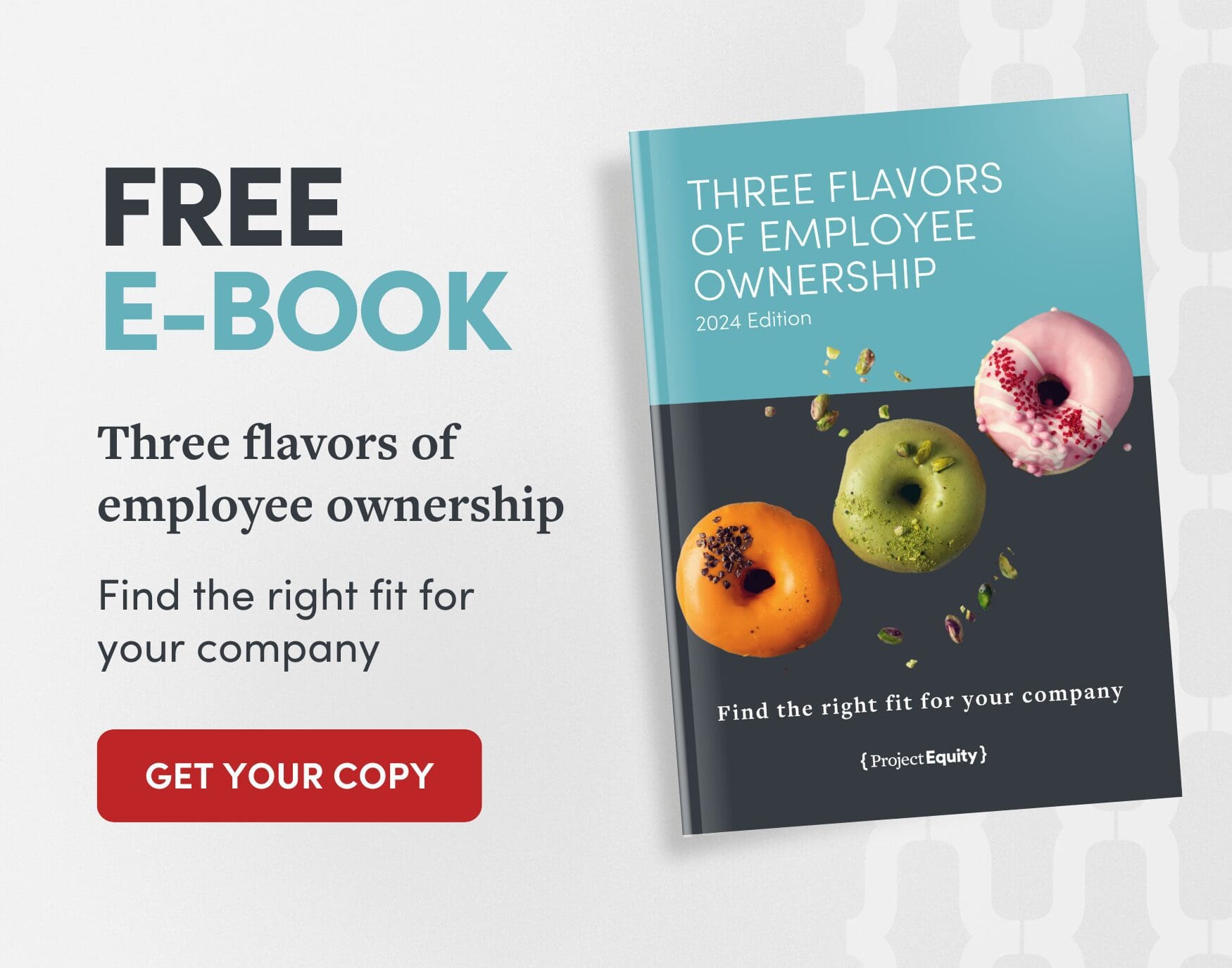Demystifying Employee Ownership Trusts
- Michelle Philippon
Employee Ownership Trusts (EOTs) are gaining attention across the U.S. as business owners look for fair, sustainable ways to plan their succession and keep their companies thriving.
Even larger companies are getting in on the action—Consumer Direct Care Network, which has 10,000+ home caregivers across 14 states, recently transferred about 30% of its shares into a trust for its employees.
But even as interest grows, many owners, advisors, and workers still ask the same question: What exactly is an Employee Ownership Trust, and how does it work?
In this blog post, I’ll break down the key ideas shared during Project Equity’s recent webinar, which you can watch below!
What is an Employee Ownership Trust?
An EOT is an employee ownership model that allows a business to be owned on behalf of its employees—but not through individual shares. Instead, a trust holds some or all of the company’s stock for the long-term benefit of the workforce.
Most EOTs in the U.S. use what’s called a Perpetual Purpose Trust (PPT). This is a type of trust that has one job: uphold a legally defined purpose. When that purpose names employees as the primary beneficiaries, the trust becomes an EOT.
That purpose might include:
- Preserving the company for future generations
- Supporting community or sustainability goals
- Strengthening employee well-being
- Protecting long-term jobs
Because the trust—not individuals—owns the shares, the company can stay mission-driven over the long run. It also avoids the risk of being resold later to the highest bidder, which can undermine the long-term legacy the founders may desire.
So, what does “ownership” mean in an EOT?
Worker-owners experience ownership in meaningful ways. Project Equity describes employee ownership through three pillars:
1. Influence
Employees gain a real voice in the business. That can happen through:
- Voting for representatives on a stewardship committee
- Serving on the committee or board
- Offering input on key decisions
2. Responsibility
Workers understand that their daily actions affect the business’s success. In an EOT-owned company, employees often feel more connected to the mission, the finances, and the long-term health of the workplace.
The long-term performance of the business becomes the responsibility of the employees; if they don’t take on this responsibility, then their future jobs might be at risk.
3. Benefit
Employees directly benefit from the company’s performance. This can include:
- Profit-sharing
- Improved benefits
- Retirement support
- Career development and promotions
Unlike employees in worker cooperatives or Employee Stock Ownership Plans (ESOPs), EOT employees don’t buy into the company, and they don’t cash out equity when they leave. Instead, they share in the company’s success during their employment.
How governance works in an EOT
EOTs include several bodies that work together to keep the business healthy and aligned with its purpose.
1. Board of directors
Just like any corporation, the board oversees major decisions such as budgeting, strategy, and hiring the CEO—plus they deal with crises that come up. The board focuses on the business’s operational success and brings accountability to the business.
2. Trust stewardship committee (TSC)
This committee ensures that the trust’s purpose is being upheld. Members may come from the workforce, management, or the community. In many designs, employees elect at least some of the committee’s members.
The TSC represents the “owner” and ensures that the desire—i.e., the “purpose”—of the owner is met.
3. Trustee (directed)
This is an administrative role. The trustee carries out decisions but does not make them, like filing taxes.
4. Trust enforcer
A trust enforcer is a “pressure valve”—a person anyone can go to if they believe that the purpose is not being met. They are empowered to ensure that the purpose is being addressed. In many EOTs, this role is rarely used, but it adds an important layer of accountability and long term sustainability for the EOT.
Companies can design these structures in different ways based on their size, complexity, and culture. Some businesses blend roles to fit their needs.
Profit-sharing: how employees benefit
Profit-sharing under an EOT is flexible. Companies can design a system based on their values, industry, and financial goals.
Common decisions include:
- How much profit to reinvest versus distribute: Many companies keep 25–50% of net income to support growth and stability.
- How to divide the employee pool: A mix of equal distribution and variable components (such as hours worked, tenure, or performance) is common.
- How often to distribute: Annual or quarterly payouts are most typical.
The goal is a balance between rewarding employees and keeping the business resilient. Part of the purpose of an EOT is the long-term sustainability of the business.
If there comes a time when profit-sharing needs to be limited to allow the business to survive a difficult situation or season, this needs to happen as the goal is to benefit not only the current employees but future employees as well.
When is an EOT a good fit?
Based on Project Equity’s experience, EOTs tend to work especially well for companies that:
- Are of any size with W2 employees
- Have a stable, consistent cash flow
- Desire to ensure the business remains employee-owned
- Do not prioritize deferring capital gains taxes
- Prefer a flexible governance and ownership structure
- Have a succession leadership team in place or actively in development
A future built on employee ownership
EOTs offer a promising path for business owners who want to strengthen their companies, support their workers, and preserve the legacy they’ve built.
As more companies adopt this model, it’s becoming increasingly clear that EOTs don’t just transfer ownership; they help build resilient, community‑centered businesses that last.
- Want insights into how EOTs differ from ESOPs and coops? Download a copy of our e-book, the Three Flavors of Employee Ownership.
- Discover why Charlie Tilt sold his manufacturing company, Hummingbird Wholesale, to an EOT as a way to continue to create good jobs in the community for years to come.
- Learn about Resource Development Associates (RDA)’s transition to an EOT.
An EOT is a trust that holds company shares on behalf of employees, giving them meaningful ownership, profit-sharing, and a voice in governance without individual stock ownership.
Employees gain influence, responsibility, and financial benefits such as profit-sharing and improved retirement or career opportunities, while helping preserve the company’s mission.
About the author
Michelle Philippon is the content manager at Project Equity, where she helps drive the organization’s storytelling by crafting and distributing content that showcases the power of employee ownership. A creative and results-driven content marketer, Michelle loves working with internal and external SMEs to provide useful insights to help small business owners, business advisors and economic developers achieve their goals.



